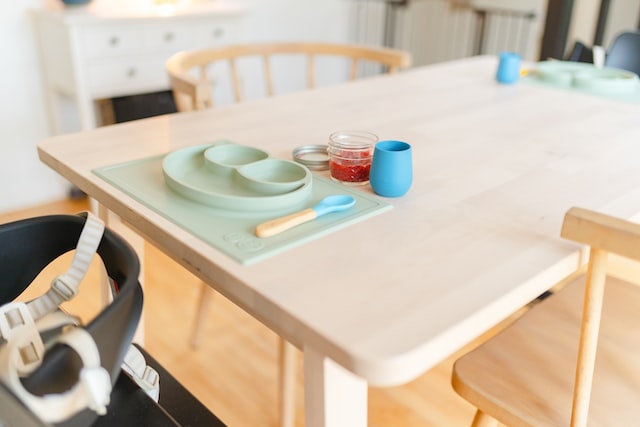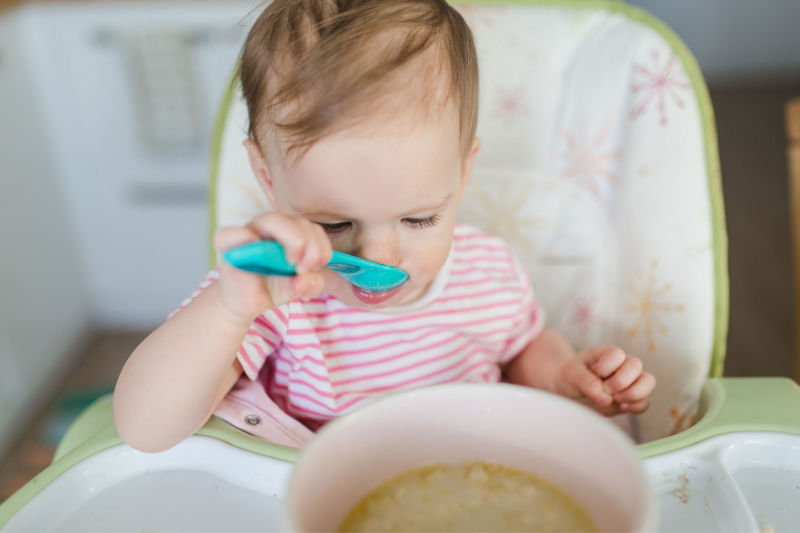
One of the toughest things about being a parent is that you also have to be a teacher in addition to being a father or mother. Babies come into the world knowing nothing but their parents’ voices. So everything from eating to caring for themselves comes from what their parents teach them. And above all things, you must first teach them how to eat.
Baby-led weaning can be one of the most difficult things to teach your child. It’s messy and repetitive, and it could be your first crack at teaching them something, but it’s necessary.
If you’re having a hard time teaching your baby how to use a spoon, here’s some advice:
What Is Baby-Led Weaning?
For the first six months of their life, your baby will depend solely on breast milk (or any appropriate infant formula if breast milk is not an option). Then, at some point, you’ll have to introduce them to solid foods—the same we adults eat at the table.
Weaning is letting your child try solid foods for the first time. While it is more common for parents to begin spoonfeeding their children purees to solid foods when they are ready, there is also a newer way of teaching your child how to eat: baby-led weaning.
Traditional Weaning
Here comes the choo-choo train! Remember when your parents told you that as they fed you? You probably don’t. Traditional weaning, or spoonfeeding a newborn, is recommended at around six months, which can be too early for you to remember.
In traditional weaning, a parent feeds a child, usually using a baby spoon, so they learn to ingest food at this age. Instead of solid foods, traditional weaning uses purees or baby food, which could be easier for your little one to ingest.
Baby Led Weaning
Baby-led weaning or ‘self-feeding,’ on the other hand, is a new feeding method parents use wherein the baby learns how to eat on their own with their own hands or utensils. In this method, a baby ‘leads’ himself to learning, hence the term ‘baby-led.’
Baby-led weaning starts around the same time as traditional weaning, six months, so you don’t have to worry about waiting longer if you’re about to decide on which method to take.
When to Start Baby-Led Weaning
As mentioned, you start feeding your baby solid foods at around six months old. But time isn’t the only factor in deciding whether or not your baby is ready for baby-led weaning. Here are some signs:
Holding Their Head up and Sitting up Without Support
Babies start without much control over their bodies, typically regular motor functions such as moving arms, legs, back, or head and neck. So when your baby starts holding their head up without much support or sitting up with no support, it could be a sign they’re ready to start ingesting solid foods.
Controlling Their Tongue
Tongue control is another skill babies learn over time. At around six months, your baby can start controlling their tongue but may not be able to master it right away. Nonetheless, it’s another sign they’re ready for solid foods.
Controlling their tongue is also another way babies can chew food or prevent themselves from choking.
Eating or Chewing Toys
Babies chewing toys is commonly seen as a sign they’re bored, but in reality, it’s another indicator that they’re beginning to search for table food. So when you see solid objects coming close to your baby’s mouth, it could be time to give them a proper meal.
The Right Solid Foods
Of course, not everything we eat applies instantly to our baby. Since they’re only starting on solids, let alone learning to self-feed, you’ll want to be careful in choosing which foods to give your baby.
Some safe options are:
- Small chunks of well-cooked meat, poultry, and fish
- Steamed or roasted vegetables
- Fruits: particularly, banana, melon, sliced berries, and avocado
Avoid fried food and food with high chances of choking your child.

Benefits of Baby-Led Weaning
While traditional weaning has been the norm, there are some benefits to baby-led weaning that the traditional method may not have.
Baby Is in Control
Baby-led weaning gives babies control over what they eat. This method allows them to choose what they eat and how much, making eating meals less of a mystery for parents. Just remember to watch out when baby is being too picky; they still need the right nutrients for proper development.
Baby Eats With The Family
Unlike traditional weaning, baby-led weaning includes your baby in the family meal plan. What the family eats, your baby eats, so there’s no more need to prepare additional meals, saving everyone’s time and money.
Baby is Exposed to Different Tastes and Textures
Even though your little one might be too young to remember the food you prepared for them when they were less than a year old, it still helps to expose them to different tastes and textures as early as you can. Baby-led weaning lets them taste food other than purees, allowing them to take their taste buds out for a spin.
Baby Experiences Eating in Full
Food is an experience and one your baby needs to have early on. It’s not just the taste they’re after. It’s the feel of food, the smell, and how it feels to chew on it with their teething gums. With traditional weaning, you do the work for them and leave them with less experience. Baby-led weaning even lets baby eat finger foods with baby’s hands!
Great Practice for Motor Skills and Hand-Eye Coordination
Baby-led weaning is also great practice for motor skills and hand-eye coordination. Allowing your baby to practice spoon feeding on themselves with a regular spoon and fork or, better yet, baby spoons or baby utensils, can help them exercise their grip and learn how to use their tiny hands.
Things to Watch Out for When Baby-Led Weaning
Of course, baby-led weaning isn’t as easy as it sounds. While there are benefits, there are still some things to look out for when you’re handing baby their first utensil.
Moderate Food Intake
One thing about us adults is we don’t always watch our food. We can get away with it (most of the time), but your baby may not. Watch out for foods high in sugar, salt, and fat. Always consider your baby when meal planning because what you eat, they will, too.
What out for what they eat and how much since you can’t control it. It’s recommended you let your child eat at their own pace, but be on the lookout for overeating; your baby doesn’t always know when to stop.
Watch Their Body Language
It isn’t easy for babies to communicate their appetite, so you should be vigilant as they are eating meals. Be present while they eat and see if they’re turning away from the food or pushing away their starting solids. It could be signs they’ve had enough.
If you see your baby gagging, rest assured that it’s normal, but too much could cause alarm. Always be on choke guard while your baby eats. Maybe you could even teach them table manners while you’re at it.

The Best Baby Spoons for Feeding Baby
Spoons are the best way to teach your baby self-feeding. Using a spoon is simple enough to get them practicing with minimal mess, and that same practice could be the start of fine motor skills. But keep in mind not all spoons are made equal.
Avoid using a traditional spoon. It could be too big and bulky for your baby’s mouth; a stainless steel utensil could make the worst first spoon for your child, so choose something a little more baby-friendly. On the other hand, the wrong spoon could lead to sore gums and baby mouth diseases, so make sure you choose the best baby spoons for your baby.
Baby utensils, especially feeding spoons and baby spoons, are a huge industry, so don’t just settle for one spoon or a second spoon—make sure you pick the right spoon for your child. Baby utensils with food-grade silicone are great upgrades to the usual stainless steel utensil.
Teaching Baby How to Use Spoons
Skipping spoon-feeding and learning how to teach baby how to use spoon by themselves could take a lot of patience, but with the right technique, you can get your baby self-feeding in no time.
One such method is the hand-over-hand method. The hand-over-hand method is placing your hand over your baby’s and guiding them as they lead the pre-loaded baby spoon into their mouth. There could be a mess, but this is one of the most efficient ways to get your baby self-feeding. The table manners can come later.
Always start by pre-loading the spoon to avoid scattering the food while it’s still in the spoon bowl. Then guide your baby’s hands as they lead the baby spoon slowly into their mouth. When finished, place your baby spoon on a spoon rest to avoid dropping it.
Ashtonbee Has The Best Baby Spoons for Your Little One
Baby-led weaning is hard enough with the wrong utensils; finding the right ones is an extra job. So check out the best baby spoons at Ashtonbee, where all our products are loved by baby!
Our spoons are made of high-quality food-grade silicone, making them soft on the gums and the best fit for your baby’s mouth. Even younger babies will have no problem learning how to eat with this in their hands!
They’re also easy to wash as they’re handwash and dishwasher-friendly, so cleanup will never be an issue. Check out our page now and be part of the Ashtonbee family!



